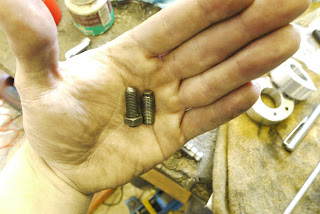After making some good progress on the engine earlier this week, there was one other thing that has been bugging me ever since I bought this bike. When I bought the bike I suspected that it had been in a crash at least at some point in its life. A few fork swaps and the fact that a rubber mallet was needed to install the upper frame in the lower frame mounts lead me to believe that the frame was buggered as well.
But before I could swan-dive into the frame swap, I decided that I had to tackled the heads first. Not very surprisingly I found a leaking valve cover. The reason it was leaking was due to a combination of really poorly executed thread repair or in other words: The threads were COMPLETELY on the proverbial p*ss.
Some fresh engine paint to make the heads look representable.
Thanks to Torsten, who built himself a lil' "special" based on a TR1, I was given quite a load of stock parts for free. Amongst those parts was one of the nicest sets of TR1 fork legs I've ever gotten my dirty ol' paws on. But because I am a notoriously skeptical guy, I chucked them in the lathe and checked them for straightness.
... and both checked out to be perfectly straight.
Next was trimming some no longer needed parts of the frame. I have a different breather setup than stock so that rear bit of pipe was no longer usefull to me.
The paint job was nothing to write home about, a coat of grey primer and then another one of satin black. I also painted the yokes, because they were looking a bit tatty and ever since I painted the lower one on the Turbo black I wanted to do the same on the mule.
The headstock bearings were due as well. Getting the old shells out was a dead easy job by adding some tacks with the MIG-gun and they almost fell out by themselves.
How to clamp two things, when you only have one free vise and one part should stay cool, while the other one is supposed to get hot. (There's a bolt clamped between the jaws to prevent the yoke from falling off.
Then the old girl was brought inside into the operation room and I started to take her apart. Oh and yes, that front wheel really was this much out as can be seen in the picture below.
Also I've had charging issues for a long time on this bike, with one of the main reasons being this plug. It's been well fried since... no idea. Cleaned the contacts and filled it with di-electric grease and it should be good until the new engine goes in, which has a good plug.
During disassembly it has turned out, that one of the forklegs was slightly bent. (This isn't related to the crash the bike must have had before my time, because those are XS1100 forks I bought second hand...)
And that's the new frame installed and among many other things, the rear subframe bolts align correctly and the airfilter base isn't bent anymore...
So you hear me going on, on just how badly bent the frame was, but then again, everybody can say that. See those brake pads?
As you can see, it's off by at least 1mm on the top. The funny thing is, you stop noticing it, when you drive it all the time only when you hop on another bike it become blatantly obvious that one of the two is vastly different.
And there she is back again in all it's crusty glory and I wouldn't want her in any other way...
... the old girl tracking straight is a nice bonus though. 😎




























































